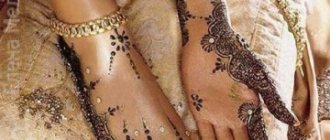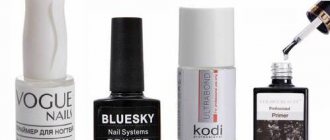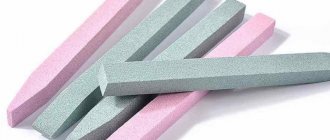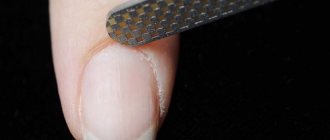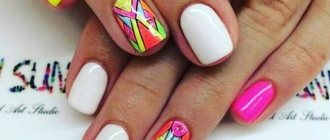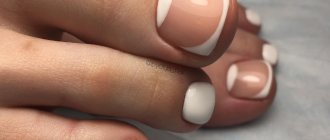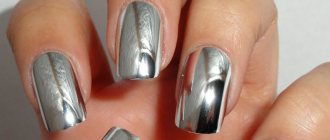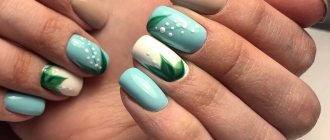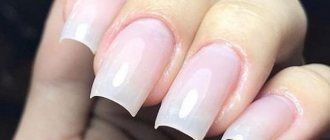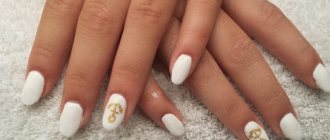A magic wand really does exist, at least in manicure. This is a buff, as everyone affectionately calls it, it is vital if you want to have beautiful, well-groomed hands. A good manicure without a buff is simply impossible; this universal file performs many functions in manicure for natural and extended nails. The right buff and using it according to all the rules will prepare your nails for any luxurious coating. Why do you need a nail buffer, why is it so good, and why should it be in any fashionista’s manicure set? Let’s find out right now.
Using the buff
Advantages of a unique nail file
The secret of the buff is that it is usually a block, each edge of which performs a specific task, and this depends on the different abrasiveness of the edges.
What is each edge needed for?
- the first side is a regular file to create the desired shape of nails, they can be shortened and trimmed;
- the second side is used to remove irregularities on the plate - burrs, roughness;
- a third party sands and removes minor imperfections;
- the fourth side polishes the plates, giving them a natural shine.
What is a nail buff
Many girls don’t even know what a nail buff is. It is a universal tool for manicure, the main task of which is to polish the plate . It finds its application both when performing manicures in a salon and when processing plates at home. Nail salons often use disposable buffs. But at the moment there are special sterilizers that allow you to disinfect nail files made of different materials, so disposable instruments of this type are losing their popularity.
Grinding, for which a nail buffer is needed in a manicure, is performed as a necessary measure to rid the plate of unevenness and imperfections. Varnishes, gel polishes and varnishes adhere to the plate only if it is perfectly flat. The principle of operation of this tool is similar to a regular nail file, the difference between them is the degree of grain, while for the buff it is finer.
The buff is a three-dimensional four-sided block. Sometimes there are numbers on its sides that have a specific meaning:
- This edge is used to give the plate the required shape.
- The second side delicately removes all roughness from the plate.
- This edge is needed for grinding and eliminating small flaws.
- The fourth side polishes the surface to a shine.
If manicure is done at home, then the buff is an indispensable multifunctional item that can cope with several tasks at the same time.
Buy buff for manicure
Let's look at the main characteristics of buffs
What materials can buffs be made from?
The base is usually made of plastic, wood, silk and other fabrics.
Working surfaces can be:
- polyethylene foam (plastic) - popular, cheap, durable. They can be sterilized;
- silicone can also be washed and disinfected, durable, inexpensive;
- The suede buff may have handles, the quality is average, it is impossible to disinfect;
- a fabric buff is of good quality, suitable for natural nails, elastic, but the cost is higher, especially for a silk-coated buff, and cannot be sterilized.
How to use it correctly
If the buff is used incorrectly, the nail plate may become deformed and pain may appear, so you must adhere to the rules.
Using the buff
We provide step-by-step instructions on how to use a nail buff when preparing for a manicure:
- apply a buffer to the nail so as to cover the entire surface of the nail plate;
- It is advisable to make a minimum of clicks;
- carefully, in the same direction, make long movements, trying not to stop in the same place;
- you cannot change the direction of movement;
- You cannot constantly use a buff; polishing must be done once a week, otherwise the nail plate will weaken and become fragile;
- The final procedure after polishing is sealing the nails. To do this, add one drop of tea tree oil and spread it over the entire surface of the edge, rubbing lightly. This will prevent your nails from peeling and make them strong;
- The instrument is reusable and requires care and disinfection.
Video
What does nail polishing involve?
Nail polishing is the process of eliminating roughness and various grooves that appear on the surface of the nails. As a result, the nails become smooth and the polish is applied evenly. But thanks to this procedure, the nail plate itself begins to grow better due to the fact that the blood vessels are stimulated. And along with the stratum corneum, bacteria that usually cause nail infections are removed from the surface of the nail.
When is nail polishing necessary? Typically, such a procedure is not done always, whenever it pleases, but only in some cases:
- if the nail contains remnants of old varnish;
- if the nails are not too smooth, with tubercles;
- the nail plate has lost its former shine.
All about abrasiveness
The different functionality of the edges is explained by different degrees of abrasiveness, that is, the size of the grains (pores) on the surface of the buff. Abrasiveness determines the hardness of each edge and is measured in grits. Let's consider the classification of abrasiveness and the functionality of the edges:
- 60-80 gr. These are hard buffs for rough polishing of extended and artificial nails and performing pedicures;
- 100-150 gr. Suitable for correcting extended nails before applying gel polish; you can correct fingernails and toenails extended with acrylic or gel plates;
- 150-240 gr. You can file down natural and artificial nails, file the tips of natural nails, polish artificial nails;
- 300-450 gr. This is a buff for natural nails, for delicate work with them. The grain size is fine, soft polishing of the surface of natural plates is possible.
Mini nail buffs
Important. Which buff to choose depends on the purpose of the tool. For thin and weakened nails, a buff with maximum abrasiveness is suitable - above 300 g. The best material is suede, which acts gently and is gentle on nails.
What is it for?
Depending on the degree of abrasiveness and appearance of the buff, it is used for:
- shaping the nail plate;
- smoothing the surface of the nails;
- polishing to add shine;
- removing remnants of overgrown skin (pterygia);
- grinding the surface to prepare for coating.
The degree of abrasiveness largely determines the functionality of the buff:
- If you need grinding and polishing of natural nails, take a buffer with an abrasiveness of 300 grit or higher (preferably 400), and for artificial nails 150-200 grit is suitable.
- To correct the shape and length of artificial nails, as well as when working with gel polish coatings, you need a file with an abrasiveness of 100-150 grit. It is also permissible to use such a buff for pedicures if the nail plate is very hard.
- Lower abrasiveness (less than 100 grit) is used only for working with the top layer of artificial turf.
Some files have a recommended method of use on each edge.
When choosing a buff, also pay attention to its size. For manicure, as well as for working with narrow nails, take small elongated files. For pedicures and wide nail plates, wider bars are more suitable.
Instrument care
Gradually, dirt and bacteria may accumulate in the bar, so it must be sterilized after each use.
Nail buffs
It is better to choose a tool with easy maintenance:
- fabric products allow water to pass through, so they are simply replaced with new ones, but can be cleaned with a brush soaked in a disinfectant;
- plastic buffs are easy to disinfect and can be washed in a warm soapy solution;
- The ideal option is to purchase several bars with different abrasiveness, from different materials and change as needed; this is an option for those who do not have to save.
Using a four-way buff
How to choose a tool for natural nails
All polishing blocks are divided according to the type of coating and abrasiveness; the variety of types of tools opens up to the consumer an extensive range, thanks to which you can easily select the necessary file. As for natural nails, the anatomical features of the nail plate should also be taken into account. The thinner the nail, the more abrasive it should be.
To work at home with natural nails, it is best to choose buffs with a parameter from 300 to 1000 grit. Accordingly, thick plates are polished with stones with a parameter of 300-500 grit, and to achieve shine from thin nails, you need to buy a product with a higher value - starting from 500 and above.
Alternative
Buff is not sold on every shelf in every store, however, it is better to find and purchase it, since there is simply nothing to replace it. A buff and a nail file differ in the quality of processing; a simple file has a rather low quality. If, nevertheless, there is an urgent need for a manicure, but there is no buff, the solution is as follows:
- any file with an abrasiveness of more than 300 gr. can help out temporarily;
- polishing, elimination of defects and irregularities can be done with any rough material, for example a piece of rough, harsh fabric.
Nail file buff
Results. A good quality buff will help to thoroughly polish your nails for gel polish coating; it will lie firmly on the nail. The life of the gel polish will be significantly extended, but you need to take into account the condition of the nail plates - if they are thin, you need to choose a softer buff.
What can replace the buff?
If you don’t have a polishing tool at hand, and your manicure urgently requires updating, the question arises of what to replace the nail buffer with. If you don’t have a buff at home, then another file with an abrasiveness of more than 300 grit will be suitable for polishing the surface of the nail. However, the result of the manicure will be different, since such nail files have a different purpose. You can polish the plate with any rough material if you don’t have a file at hand, and an unevenness has formed on the surface of the plate that interferes with the usual actions.
Drawing a conclusion, it must be said that the buff is an indispensable thing for a high-quality manicure at home. When choosing a nail file, you should be careful, since by choosing inexpensive models, saving money can ruin your nails for a long time.
We recommend visiting our Manicurist Forum , where you can ask questions or chat about interesting topics!
